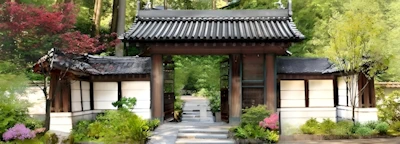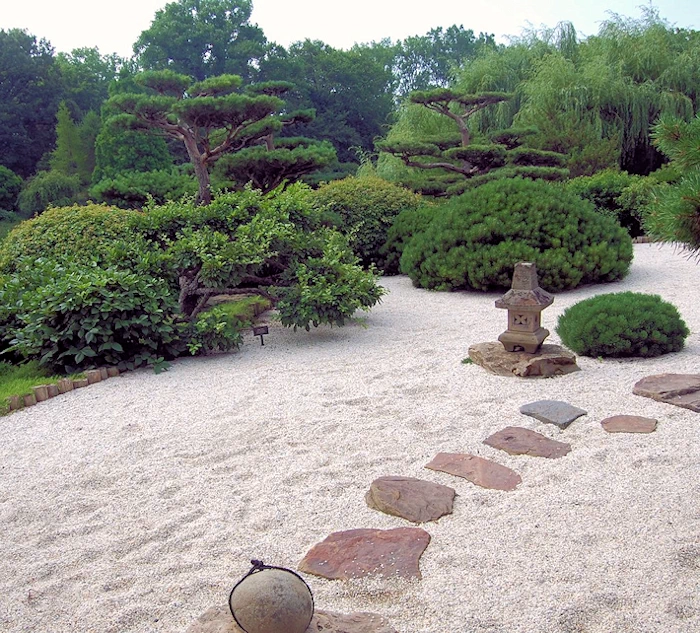Chicago Botanic Garden, Elizabeth Hubert Malott Japanese Garden
Event Location
Glencoe, IL 60022
Tour the Malott Japanese Garden (Distance: .165 miles Time: 25-35 mins)
Stop 1: The Ken
A tour of the Japanese Garden can be a thought-provoking experience. Sansho-en is a garden in the Japanese style, though it is not a garden of Japanese plants. Instead, Midwest-hardy plants are chosen, then pruned and presented in Japanese style.
In this garden, each plant stands on its own and every decorative element has meaning: especially the 13 lanterns you may discover throughout the garden. At this spot you are approaching Sansho-en, The Garden of the Three Islands. From this viewing point, called the Ken, all three islands can be seen at once: Keiunto at right, Seifuto at center, and Horaijima at left.
Sansho-en is a garden of the kaiyu-shiki or promenade style, in which the visitor walks a path of discovery, as if on a journey. This 17th-century style is known for carefully composed views that are glimpsed…concealed…and revealed…to the alert observer.
Stop 2: The 'Waterfall'
Plants often mimic nature in the Japanese garden. Here, boxwood represents stones and cotoneaster flows downhill like water - mimicking the layout of the waterfall garden located above.
Stop 3: Kasuga Stone Lantern
In Japan, lanterns originally held votive offerings in temple compounds; later, tea masters introduced them into gardens to light the way to the evening tea ceremony.
Kasuga lanterns take their name from the Kasuga Shrine at Nara, Japan. There, nearly 1,000 lanterns - identified by pedestal bases and fire boxes decorated with symbolic panels (doe, stag, sun, moon) - line the path leading to the temple.
Stop 4: Japanese Garden Bridge
In Japan, a garden bridge is a symbolic link between this world and paradise; an arch suggests the difficulty of the path. Sansho-En's graceful wooden bridge carries the visitor 'from everyday life to a calm, serene, reflective communion with nature,' says Dr. Koichi Kawana, the garden's designer.
As you cross, notice how your step slows on the incline, how your breathing changes, and how your awareness heightens...
Stop 5: Keiunto
Keiunto, the Island of the Auspicious Cloud, is the largest, highest, and most formal of the three islands.
Traditional Japanese gardens portray an idealization or abstraction of the Japanese landscape, and speak to a spiritual philosophy that emphasizes man's oneness with nature.
Greens and subtle colors predominate here, yet every season brings a burst of fleeting color:
Spring: Azaleas
Summer: Iris and lespedeza
Fall: Autumn leaves
Winter: Conifers outlined in snow
Stop 6: Dry Landscape Garden (Karesansui)
In Edo times, a daimyo (feudal lord) or aristocrat telegraphed wealth via his estate and gardens. This elegant, cedar-shingled gate indicates that the garden beyond is large and grand.
The roof tiles are called ichimonji because they are shaped like the Japanese character for the number one.
Beyond the gate is a dry garden, an abstraction of nature: smooth gravel represents calm water, while raked rippled patterns suggest waves breaking on a shore.
Stop 7: Arbor (Azumaya)
One of the most private and restful spaces at the Chicago Botanic Garden, the arbor is beautifully crafted, adapted from a building at Kodai-ji, a Kyoto temple built in the 1600s. Outside, notice the polished cedar and the pyramidal hogyo roof ; inside, look up to the kasatenjo or umbrella ceiling.
The dry garden is a viewing garden, meant to be appreciated from the arbor house.
Stop 8: Crouching basin (Tsukubai)
Before guests enter a teahouse, they stop to perform a ritual purifying of body and soul. At a basin set low on the ground, guests must crouch, in a position of humility, in order to wash hands and rinse mouths.
The basin sits in a sea of pebbles, or umi, with three flat stones in front of it: a large one for crouching (mae-ishi); and two smaller stones to hold a pail of heated water (yuoke-ishi at right) and a candle (teshoku-ishi at left).
Stop 9: Zigzag Bridge (Yatsuhashi)
While legend holds that humans can elude evil spirits by crossing a zigzag bridge (evil spirits move only in straight lines), a zigzag bridge in a garden also has a practical purpose: to slow visitors' progress, thus encouraging them to enjoy the beauty around them.
As you cross the granite slab bridge to Seifuto, note the intentionally disordered wooden posts that line the shore. Called ranqui, they prevent erosion while adding rustic simplicity.
Stop 10: Seifuto
As you enter Seifuto, notice that the pine grove and the hill on which it stands block your view of the rest of the island. What comes next will be a surprise; that construction of surprises is called mie-gakure, literally, 'seen and hidden.'
Near the stone lantern is a grouping of boulders. In a Japanese garden, rocks are often partially buried to look as though they have been there a long, long time.
Stop 11: Boat Landing Stones (Horaijima)
Two large granite slabs create an ornamental boat landing called funatsuki-ishi. In Japan, no location is more than 75 miles from the sea; the boat landing is a reminder of that island heritage.
Legend says that immortals dwell on Horaijima, the Island of Everlasting Happiness. Thus mortals may view it from a distance but neither bridges nor paths allow access. On Horaijima, pine trees are planted sparsely and pruned more to suggest great distance.
Stop 12: Dry Garden and Arbor House
Called the Island of Clear, Pure Breezes, Seifuto takes advantage of its location: cool air blows across the lake and through the Arbor House, making it a haven for visitors on a hot summer day. The views are lovely on all four sides.
Although the dry garden on Seifuto is smaller and more intimate than that on Keiunto, there are nice details: note the water basin and its attendant lantern tucked in on the right.
Stop 13: Willow
The naturally uneven pathway stones which you just traversed are a deliberate choice: the visitor must look down, walk slowly, and watch every step. Only at the end of the stones can the gaze be lifted - to a beautiful new view down the path.
At this excellent vantage point, look up into the willow to see how severely it's pruned to control its size. Allowed to grow freely, willows would be disproportionately large and out-scaled for this garden.
Stop 14: Pine Trees
Pine trees are symbols of long life. Age is revered in Japan, so trees are made to look older by pruning, shaping, and training. The branches of many of the Scots, Jack, and Austrian pine trees here are tied down - trained horizontally to suggest the weight of years.
In spring, each branch tip on the garden's 172 pines sprouts new growth, which has to be hand-plucked (called candling) to maintain the tree's size and shape.
Stop 15: Shoin House
The jewel of Sansho-en, the Shoin House recreates the garden retreat of an Edo-period feudal lord. The entire building was constructed in Japan, disassembled, shipped to Chicago, then reassembled on-site by the same artisans who handcrafted it.
Inside, at a combination window/desk, or shoin, the aristocrat could study, read, or write poetry. Traditional Japanese items-scrolls, cushions, flower vases-decorate the interior.
Stop 16: Water Basin at the Shoin House
At the railing of the Shoin House is a square purification basin, called a hachimae. It is designed to be used from the porch or veranda of a building: the guest reaches out towards the basin to perform the ritual washing. The checkerboard motif, or kesa pattern, references the ceremonial robes of priests at the famous Silver Pavilion, Ginkaku-ji, in Kyoto, Japan.
Stop 17: Snow-viewing Lantern (Yukimi-dōrō)
In Japan, a snow-covered garden is considered one of the loveliest scenes of the year. A yukimi lantern, built low to the ground with sturdy legs and a broad, snow-bearing umbrella, is thought most beautiful when piled high with snow and reflected in nearby water.
Stop 18: Puryear Point
Another of the Chicago Botanic's 'secret places,' Puryear Point has great bridge views and vistas, sculptures that double as seating, and some of the best shade at the Garden.
What to view? Walking Guide
Japanese Garden Design. Visitors to Japanese gardens often have questions about the types of plants they see, the design of the garden and the objects that are positioned around the garden. The horticulturist for Sansho-En, the Japanese Garden at the Chicago Botanic Garden, has answered some of the most common questions:
WHAT IS THE SIGNIFICANCE OF THE ROCKS PLACED AROUND THE GARDEN?
Rocks are considered to be the 'skeleton' of the earth and of a garden; they are the first element put into a garden during construction. Skilled rock setters can make rocks look as if they have been a part of that setting forever.
WHY ARE THE PLANTS SO HEAVILY PRUNED?
The goal behind Japanese garden design is to make a representation of nature. The plants are pruned and groomed to appear ideal or almost perfect. During the growing season, most shrubs are pruned every two weeks. Pines and large deciduous trees are pruned up to three times per year, as needed. The act of grooming and pruning makes the gardener become one with the plant and with the garden. In most homes in Japan, it is a daily ritual to groom a garden by removing dead leaves and insects, pruning plants, and finally, sweeping the garden clean.
WHAT ARE THE WATER BASINS FOR?
Water plays a very important role in Japanese gardens. Basins are placed throughout the garden in special locations to allow visitors to purify themselves, both physically (by washing their hands and drinking the water) and spiritually (by symbolically washing away their cares).
WHAT IS A ZEN GARDEN?
The term 'Zen garden' was coined in the 1950s to refer to the abstract rock and sand gardens found at Zen Buddhist temples in Japan. The correct term for this type of garden is karesansui, or dry garden. Many of these gardens are made strictly of sand or gravel beds along with an arrangement of boulders. Others may include plants. The sand in a dry garden is raked in patterns representing waves, ripples or even rice paddies. Other patterns are simply abstract and follow the flow of the garden.
ARE ALL THE PLANTS IN JAPANESE GARDENS FROM JAPAN?
The plants in Sansho-En were chosen because they grow well in the Chicago area, not because they are native to Japan. Some Japanese plants require an acid soil instead of the Midwest's alkaline soil, while others cannot tolerate the region's cold winters. All gardeners must understand the growing conditions for their plants before placing them in a garden. Any plant may be used in a Japanese garden if it conforms to the design of the garden and is maintained according to Japanese gardening principles.
WHY AREN'T THERE MORE FLOWERS IN THE JAPANESE GARDEN?
There may not be many flowering perennials or annuals, but there are many flowering plants. They're chosen specifically for their short bloom time to reflect the fleeting quality of human life, which is in direct contrast to the infinite nature of the rocks. On Sansho-En, look for iris, rhododendron, plum, quince, and magnolia, among others.
WHAT IS THE SIGNIFICANCE OF THE STONE LANTERNS?
In Japan, lanterns were used to light paths outside Buddhist temples. When a new garden was added, old temples were raided for rocks, plants, and lanterns. When teahouses became popular, gardens were added to them, and the garden quickly became an important part of the tea ceremony itself. Since tea ceremonies were often performed at night, lanterns would light key areas of the garden. Whether used for lighting or ornamentation, lanterns should be located where a path turns or near a gate or doorway.
ARE THERE STATUES OF BUDDHA IN THE GARDEN?
Buddha statues, as well as other religious artifacts, are used mainly in temple gardens. Homeowners, however, might have one or two artifacts in their own gardens, either as good luck charms or for private worship.
WHAT IS THE IMPORTANCE OF PATHWAYS IN A JAPANESE GARDEN?
Paths are designed to guide visitors through the garden and allow visitors to see the garden from many angles. Designers can hide a view to create mystery or to open up a beautiful vista for a visitor turning a corner on a path. Paths keep visitors from damaging fragile ground covers such as moss and sedum. Paths in the dry gravel gardens also allow visitors to enjoy the garden without disturbing the carefully raked patterns and smooth surfaces.
WHEN IS THE BEST TIME OF YEAR TO VISIT THE JAPANESE GARDEN?
Sansho-en is designed as a public stroll garden. The plants were chosen because their ornamental characteristics appear at different times throughout the year. In spring, crabapples and azaleas are particularly beautiful. In early summer, irises bloom, cattails show off, and visitors can enjoy all the various textures and shades of green. In fall, bush clover blooms, cascading chrysanthemums line the walkways, and the leaves of many trees and shrubs begin to turn brilliant colors. Winter holds special interest because of the way snow piles on the pruned junipers, looking like blossoms about to burst, while the pine trees create fascinating shadows on the snow-covered ground. At all times of the year, the peaceful nature of the garden allows visitors to sit quietly, listen to the birds, and enjoy the beauty of the garden.
Contact
Phone: (847) 835-5440Location Website
Click to Visit
(For Event Information See Event Website Page)
Authentic Japanese Gardens (United States)
Best Japanese Gardens in the United States
Japanese Rock 'Zen' Gardens (United States)
Best Japanese Rock 'Zen' Gardens in the United States
Japanese Teahouses (United States)
Best Japanese Teahouses in the United States

















